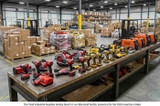The Benefits of Using Air Tools in Automotive Repair
Here is the audio of this Article
This article focuses on the advantages of using air tools in automotive repairs, such as the speed and precision they offer, as well as their cost-effectiveness compared to other tools, such as those powered with batteries or those with electrical cords that are connected to electric mains.Additionally, the article could include information on the types of air tools available, how they are used, and safety tips when using them. Increased Efficiency: Air tools are designed to be lightweight, so they require less effort to use than traditional hand tools. This makes them ideal for automotive repairs, as they allow technicians to work faster and more efficiently, reducing the time it takes to complete a job. There is also the advantage of reduced wear and tear, Air tools are built to last, and with their lack of physical contact, they don't cause the same amount of wear and tear to the parts they're working on. This means technicians don't need to replace their tools as often, saving money over time. Another crucial feature of air tools is that they are easier to use than hand tools, so technicians don't have to exert as much effort when using them. This reduces fatigue and allows technicians to work for more extended periods without tiring out. Finally, while using air tools, there is always less Mess: Air tools don't create as much mess as hand tools, so technicians can make less of a mess when they work with these tools.
Benefits of Using Air Tools Over Manual Tools in Automotive Repairs
1. Speed: Air tools are generally much faster than manual tools regarding automotive repairs. They can quickly and efficiently complete various tasks, from changing tires to tightening bolts. This can significantly reduce the time it takes to complete a job.
2. Power: Air tools can generate much more power than manual tools, meaning they can easily handle more demanding tasks, and makes them perfect for jobs that require a lot of force, such as loosening rusted bolts.
3. Durability: Unlike manual tools, air tools are designed to withstand the wear and tear of automotive repairs. Their internal parts are built to last, so they won't need to be replaced as often. This makes them a great investment for any automotive shop.
4. Versatility: Air tools can be used for various applications, from drilling to sanding. They can even be used to power special attachments, such as polishers and buffers. This makes them an excellent choice for shops that need to complete various jobs quickly.
5. Cost: Air tools are typically more expensive than manual tools, but the cost can be quickly offset by the time saved.
The Cost Savings of Air Tools for Automotive Repairs
Air tools are a great way to save time and money for automotive repairs. They are incredibly efficient and can help get a job done quickly and efficiently. Air tools have become increasingly popular as they are more cost effective than traditional tools and require less maintenance.
The cost savings of air tools for automotive repairs are numerous and can be significant. Air tools are powered by compressed air rather than electricity or gasoline, making them significantly more energy-efficient than electric or gasoline-powered tools. This energy efficiency translates into cost savings by reducing energy consumption and lowering electricity and fuel bills. Air tools are also more robust and durable than their electric and gasoline counterparts. This means that they can be used more extended before needing to be replaced. This is important for automotive repairs as it helps to reduce repair costs and the need for frequent replacements. In addition, air tools are more precise and accurate than electric or gasoline tools. This is because the compressed air used to power the tools is evenly distributed throughout the tool, allowing for more consistent and accurate performance. This is especially important in automotive repairs, where accuracy is a must.
Additionally, they are lighter and easier to store and transport. We can break down the cost savings of using air tools for automotive repairs into several categories. The first is the cost of the tools themselves. Air tools are usually less expensive than traditional tools, and they often come with more than one tool in the same set, meaning you can save money by purchasing more than one item at once. Additionally, air tools often come with a warranty, which can save you money in the long run if something goes wrong. Another cost saving of air tools for automotive repairs is the cost of labor. Air tools are much faster than traditional tools, meaning you can get the job done quicker. This can help you save time and money on labor expenses. Air tools are often lighter and easier to maneuver than traditional ones, which can also help you save time and money on labor. The maintenance cost is another area where air tools can save you money. Traditional tools often require a lot. Overall, the cost savings of air tools for automotive repairs are clear. By being more energy efficient, durable, and handy,
Time Savings
Air tools for automotive repairs offer several time-saving benefits for mechanics and DIYers. Air tools are powered by compressed air generated by either an air compressor or a shop air system: This means that air tools are fast, powerful, and reliable, allowing mechanics and DIYers to complete automotive repairs in a fraction of the time it would take to do the same job with a manual tool. Air tools are also much more efficient than manual tools. For example, an air ratchet can move nuts and bolts in a fraction of the time it would take to do the same job as a manual ratchet. Air tools are also more accurate, providing consistent torque and power to ensure the job is done correctly. Air tools also offer more control over the tool's speed, allowing mechanics to make precise adjustments to their work. In addition to the time savings, air tools are also more durable than manual tools. Air tools are designed to withstand higher levels of torque and pressure, meaning they are less prone to wear and tear and can last longer than manual tools. This means that mechanics and DIYers can save time by not having to replace their tools constantly. Finally, air tools require less physical effort than manual.
Safety Benefits
Using air tools for automotive repairs can provide several safety benefits for those working on cars. Air tools are safer than traditional hand tools, as they are powered by compressed air instead of electricity, eliminating the risk of shock or electrocution. In addition, air tools are typically lighter than their electric counterparts, making them easier to maneuver and reducing the risk of injury from repetitive strain or fatigue. Air tools also tend to be quieter than electric tools, which can help reduce noise pollution in the work area and prevent hearing loss for those working with them. As air tools are powered by compressed air, they also create less vibration than electric tools, which can help reduce the risk of repetitive stress injuries. Air tools also require less maintenance than electric ones, as fewer moving parts exist, making them less likely to break down and need repairs, reducing the risk of injury from faulty equipment.
Conclusion and safety while working
Finally, we recommend all users of air tools use them safely, following basic safety precautions for handling power tools and particularly air tools. Have adequately covered the most critical safety advice for using automotive air tools
1. Always wear safety goggles or a face shield while using air tools.
2. Ensure all air lines are correctly connected and secured before operation.
3. Ensure the air pressure is set to the correct value before use.
4. Regularly inspect the tool for any signs of wear or damage.
5. Disconnect the tool from the air supply before making any adjustments.
6. Store air tools in a cool, dry place to avoid potential damage from moisture and temperature fluctuations.
7. Ensure the hose is secured correctly and routed to avoid potential tangles or snags.
8. Keep your work area free of debris and other items that could cause a slip-and-fall accident.
9. Keep your hands away from moving parts while the tool is in use.
10. Use only the correct size sockets and attachments for the job.









